Emergeny Medicine > EXAM > PHTLS Pre & Post Test Answered; 100% Answered correct. (All)
PHTLS Pre & Post Test Answered; 100% Answered correct.
Document Content and Description Below
PHTLS Pre & Post Test Questions & Answers_ All correct. The displacement of tissue away from the path of a projectile, both temporarily and permanently, is known as: A. Conization B. Cavitati... on C. Crepitation D. Contusion The single most important factor in determining the potential for injury due to energy exchange is: A. Mass of the bodies involved B. Velocity of the bodies involved C. Density of the tissues involved D. Surface area of the impact involved In the management of shock, isotonic crystalloid solutions, such as Ringer's, are preferred because: A. The protein molecules in crystalloid solutions act as volume expanders B. These fluids draw interstitial fluid into the vascular space to enhance volume C. These solutions will stay in the vascular space longer than water solutions, such as D5W D. Their pH enhance oxygen delivery to the tissues With respect to the distance of a fall, which of the following is a guideline for determining a critical fall? A. 3 times the height of the patient B. 2 times the height of the patient C. 5 times the height of the patient D. 1 ½ times the height of the patient The phase of an explosion, or blast, in which hollow organs are squeezed and may rupture is called the __________ phase. A. Tertiary phase B. Quaternary phase C. Secondary phase D. Primary phase During the primary survey and management of a trauma patient, the E in ABCDE stands for _________? A. Edema B. Eyes & ears C. Expose/Environment D. Electrical therapy The time in which surgical intervention can make a difference in patient outcome is the __________? A. Golden period B. Golden time C. Golden era D. Golden minutes In the absence of extenuating circumstances, the maximum amount of time it should take to identify and manage immediate threats to life, prepare the patient for transport and begin transport is _________? A. 5 minutes B. 10 minutes C. 15 minutes D. 30 minutes In which of the following situations is the use of a short spinal immobilization device indicated? A. 28 year old male, unrestrained driver in a frontal impact crash. Awake, asks repeatedly what happened, complains of a headache, has a hematoma on his forehead. BP 122/84, HR 92, VR 20. B. 40 year old female who was pushed down a flight of stairs and is lying prone on the landing between two flights of stairs, complaining of back pain. BP 118/78, HR 100, VR 20. C. 17 year old female, restrained driver in a frontal impact crash. Awake, pale and diaphoretic, complains of upper right quadrant abdominal pain. BP 100/70, HR 108, VR 20. Your patient is a 32 year old man, restrained driver of a vehicle that has been involved in a frontal impact with a concrete bridge abutment. The patient is awake, but has difficulty answering questions due to shortness of breath. His ventilatory rate is 30 per minute. Of the following choices, when is the first time the patient's breath sounds should be checked? A. As soon as he is removed from the vehicle B. Prior to being removed from the vehicle C. As soon as he is immobilized on a long backboard D. Enroute to the trauma center Which of the following represents adequate spontaneous ventilation in an adult? A. Tidal volume 100 mL, ventilatory rate 40/minute B. Tidal volume 500 mL, ventilatory rate 8/minute C. Tidal volume 300 mL, ventilatory rate 16/minute D. Tidal volume 600 mL, ventilatory rate 12/minute Which of the following is 100% accurate in verifying endotracheal tube placement? A. Pulse oximetry B. End-tidal capnometry C. Syringe aspiration D. None of the above When utilizing percutaneous transtracheal ventilation, the correct ration of lung inflation to lung inflation time, in seconds, is: A. 1:4 B. 1:5 C. 1:2 D. 2:2 Which of the following is a possible complication of using a manually triggered oxygen powered device for ventilation? A. Gastric distention B. Pneumothorax C. Inability to feel lung compliance D. All of the above Which of the following procedures is considered an essential airway skill? A. Needle cricothyroidotomy B. Endotracheal intubation C. Insertion of an oropharyngeal airway D. Retrograde endotracheal intubation Pericardial tamponade is most likely to occur in which of the following situations? A. Stab wound to the chest B. Fall from a height C. Frontal impact vehicle crash D. Gunshot wound to the chest Which of the following is the preferred site for needle decompression of a tension pneumothorax? A. 4th intercostal space, midclavicular line, just over the top of the 5th rib B. 4th intercostal space, midclavicular line, just below the 4th rib C. 2nd intercostal space, midclavicular line, just over top of the 3rd rib D. 2nd intercostal space, midclavicular line, just below the 2nd rib Which of the following is the mechanism by which pulmonary contusion interferes with oxygenation? A. Inability to generate negative intrapleural pressure B. Decrease in vital capacity due to collapse of the flail segment C. Increased intrathoracic pressure D. Blood and fluid in the alveoli and interstitial spaces of the lung Your patient is a 55 year old male who was struck in the right side of the chest with a piece of steel pipe. He presents with uncooperative behavior, his skin is pale and moist, the ventilatory rate is 32, there is a weak radial pulse of 112, and breath sounds are decreased on the right side. The trachea is midline and jugular veins are flat while the patient is supine. There is isolated crepitus over the 4th and 5th ribs in the midaxillary line on the patient's right side. Based on the mechanism of injury and the assessment findings, which of the following is the most likely cause of the patient's signs and symptoms? A. Tension pneumothorax B. Simple pneumothorax C. Pulmonary contusion D. Hemothorax Deterioration of ventilation and oxygenation after inflation of a PASG in a patient who has sustained a high-pressure compression injury of the abdomen, such as a sudden deceleration with the lap belt placed across the abdomen, most likely represents which of the following injuries? A. Abdominal aortic aneurysm B. Ruptured diaphragm C. Ruptured esophagus D. "Paper bag" syndrome of the lungs Which of the following is NOT a component of the Fick Principle? A. Adequate number of platelets in the blood B. Oxygenation of red blood cells C. Transportation of red blood cells to the tissues of the body D. Off-loading oxygen from the red blood cells to the tissues One of the earliest signs of hypovolemic shock is: A. Hypotension B. Bradycardia C. Anxiety D. Reduced urine output Which of the following characterizes the washout phase of shock? A. Systemic acidosis B. Localized tissue acidosis C. Edema D. Reduced capillary blood flow A trauma patient who has fallen 20 feet from an apartment balcony is alert with warm, dry, pink skin, with normal capillary refilling time to the lower extremities, and is hypotensive. The upper extremities are cool, pale and diaphoretic. Which of the following injuries should be suspected? A. Aortic dissection B. Liver laceration C. Fractured pelvis D. Spinal cord injury Which of the following is a limitation of prehospital fluid resuscitation of the patient in hemorrhagic shock? A. Inability of fluids to carry oxygen B. Pulmonary edema C. Increased hemorrhage D. All of the above Which of the following statements regarding signs of intraabdominal injury is NOT true? A. Fresh blood in the abdominal cavity does not cause signs of peritonitis B. A significant amount of blood loss occurs before abdominal distention can be noticed C. Substantial intraabdominal hemorrhage always causes tenderness and abdominal rigidity D. Signs and symptoms of shock greater than can be explained by other injuries is a reliable indicator of intraabdominal injury Which of the following assessment techniques is least useful in the prehospital assessment of the patient with suspected intraabdominal trauma? A. Palpation B. Auscultation C. Inspection D. Scene assessment Pregnant trauma patients should be placed on the left side because: A. This prevents seizures due to eclampsia B. This prevents abruption of the placenta C. This prevents compression of the vena cava D. This is the best way to auscultate fetal heart tones Survival of the fetus in a trauma situation is most dependent upon which of the following factors? A. Gestational age of the fetus B. Prenatal care C. Immediate cesarean section D. Good resuscitation of the mother A patient struck in the back of the head with a baseball bat may sustain a cerebral contusion to which area of the brain? A. Frontal and occipital B. Occipital C. Parietal D. Frontal In the context of the caring for an adult patient with traumatic brain injury who is deteriorating and exhibiting signs of herniation, hyperventilation means ventilating with a BVM and 100% oxygen at a rate of: A. 12 to 16 per minute B. 32 to 40 per minute C. 8 to 12 per minute D. 20 per minute In the United State, which of the following mechanisms most frequently causes spinal cord injury in adults? A. Shallow water diving B. Vehicle crashes C. Falls D. Pedestrian struck by a vehicle Which of the following presentation indicate spinal cord injury? A. Complete loss of sensory and motor function below the site of injury B. Weakness and parethesia in the upper extremities, but normal function in the lower extremities C. Complete loss of function on one side of the body and loss of pain and temperature sensation on the opposite side D. All of the above Of the following, which is the earliest indication of compartment syndrome? A. Paralysis of the affected muscles B. Loss of pulses C. Loss of feeling in the web space between the thumb and index finger or between the first and second toes D. Tense swelling of the involved area A traction splint may be used for which of the following injuries? A. Knee dislocation B. Pelvic fractures C. Femur fractures D. All of the above Which of the following descriptions meets the criteria for transport to a facility with a burn unit? A. A 49 year old female with a partial thickness burn from her elbow to her shoulder B. A 25 year old male with an electrical burn across his chest C. A 9 year old make with superficial burns on the backs of both legs D. A 32 year old female with a partial thickness burn about twice the size of her hand on her back The preferred method of dressing burns in the prehospital setting is: A. Dry sterile dressing B. Moist sterile dressing C. Wet dressings D. Petroleum gauze In assessing the hypothermic patient in the prehospital setting, the most reliable indicator of the severity of hypothermia is: A. Rectal temperature B. Oral temperature C. Heart rate < 60 D. Presence or absence of shivering In the normal child, which general statement is most accurate in comparison with the adult patient? A. Blood pressure is higher, hear rate is higher, and ventilatory rate is higher B. Blood pressure is lower, heart rate is lower, and ventilatory rate is higher C. Blood pressure is lower, heart rate is higher, and ventilatory rate is higher D. Blood pressure is lower, heart rate is higher, and ventilatory rate is lower A patient who withdraws from painful stimuli, opens eyes on verbal command, and cannot speak because of intubation has a Glasgow Coma Scale of which of the following: A. 8 B. 8T C. 7 D. 7T The earliest site for intraosseous infusion is: A. Anterior tibia, just above the tibial tuberosity B. Anterior fibula C. Anterior tibia, just below the tibial tuberosity D. Posterior fibula Which of the following behaviors is the most reliable indication of confusion in the elderly trauma patient? A. Inability to recall his/her name B. Inability to recall the day of the week C. Inability to identify his/her present location when out of his/her normal residence D. Focus on repeated retelling of events that occurred years ago In the elderly trauma patient a high index of suspicion for shock should occur beginning when the systolic blood pressure is less than: A. 90 mmHg B. 150 mmHg C. 120 mmHg D. 100 mmHg In an adult patient, blood loss into the tissue from a fractured femur may be as much as which of the following? A. 150 to 500 mL B. 500 to 1000 mL C. 1000 2000 mL D. 2500 to 5000 mL Delayed death due to trauma is usually a result of: A. Biochemical and pathophysiological effects of inadequate initial resuscitation B. Acute circulatory failure C. Brain injury D. Acute hypoxia A regional resource center with a full spectrum of trauma services from prevention to rehabilitation which serves as the leader in trauma care for a geographical region is a: A. Level IV trauma center B. Level III trauma center C. Level II trauma center D. Level I trauma center Which of the following patients is not indicated for spinal immobilization? A. Intoxicated patient in a MVC B. Patient who fell 8 feet and lost consciousness C. Patient complaining of pain on palpation of the neck D. Patient with a knife wound to the chest and a GCS of 15 The premise of PHTLS is that: A. EMTs must treat all trauma patient based on protocols B. EMTs are capable of sound patient care judgment, given an adequate knowledge base C. EMTs must work only under on-line medical direction when caring for trauma patients D. EMTs are capable of working independently of medical direction - B. EMTs are capable of sound patient care judgment, given an adequate knowledge base Which of the following warrants classification of a patient as a critical trauma patient? A. An extremity fracture B. Preexisting major medical problem C. Bleeding from the nose D. Deployment of air bags in a motor vehicle crash Which of the following is the foundation of effective trauma care? A. Protocols permitting invasive airway procedures B. The ability to administer large amounts of crystalloid fluids C. The ability to quickly locate and manage life-threatening and potentially life-threatening injuries D. Effective spinal immobilization skills You arrive at the scene of a motor vehicle collision in which a vehicle struck a tree. Which is the best indicator of potential injury? A. Circumference of the vehicle B. Diameter of the tree C. Mass of the vehicle D. Speed of the vehicle The potential for death or serious injury is greatest in which of the following motor vehicle collisions? A) Down and under B) Ejection from vehicle C) Lateral compression D) Up and over Bilateral femur fractures are most often associated with which type of motorcycle crash? A) Angular impact B) Bike-road impact C) Head-on impact D) Rear impact Which is the preferred fluid for resuscitation of hemorrhagic shock in the prehospital setting? A) 5% dextrose in water B) 7.5% hypertonic saline C) Hetastarch D) Lactated Ringer's Which is the most common cause of upper airway obstruction in the trauma patient? A) Blood B) Teeth C) Tongue D) Vomitus Which is the preferred adjunct device for verifying placement of an endotracheal tube in a patient with a perfusing rhythm? A) End-tidal CO2 monitoring (capnography) B) Esophageal detector device C) Pulse oximeter D) Stethoscope Which is the most important reason to maintain an open airway in the trauma patient? A) Prevents aspiration and pneumonia B) Prevents hypoxemia and hypercarbia C) Prevents snoring respirations D) Prevents the tongue from blocking the pharynx Essential airway skills include manual clearing of the airway, manual maneuvers, suctioning and which of the following? A) Dual lumen airway B) Endotracheal intubation C) Laryngeal mask airway D) Oropharyngeal airway Your patient is a middle aged male who crashed his motorcycle. He is unresponsive. After opening the airway using a modified jaw thrust, you note the patient has respirations at a rate of 6. Auscultation reveals breath sounds are absent on the left side. Which of the following is the most appropriate next intervention? A) Apply a non-rebreather mask B) Begin ventilation with a BVM C) Insert an endotracheal tube D) Perform a needle decompression Which best describes shock? A) Decreased Glasgow Coma Scale (GCS) B) Flushed, dry, hot skin combined with bradycardia C) Generalized inadequate tissue perfusion D) Low blood pressure combined with tachycardia Your patient has a deep laceration to his antecubital fossa with significant bleeding. What is the most appropriate initial action? A) Apply a tourniquet B) Apply direct pressure C) Initiate rapid transport D) Restore blood volume Hypotension of unknown etiology in a trauma patient should be assumed to result from which of the following? A) Blood loss B) Cardiac tamponade C) Spinal injury D) Tension pneumothorax Which assessment is most beneficial in differentiating hemorrhagic shock from neurogenic shock in the prehospital setting? A) Abdomen B) Blood pressure C) Neurologic status D) Skin The body initially compensates for blood loss through activation of which of the following? A) Parasympathetic nervous system B) Reticular activating system C) Spinal reflex arcs D) Sympathetic nervous system Medication used by trauma patients for pre-existing conditions may cause which of the following? A) Herbal preparations may enhance blood clotting B) Anti-inflammatory agents may enhance blood clotting C) Beta blockers may prevent tachycardia with blood loss D) Calcium channel blockers may slow the onset of shock The target blood pressure for a trauma patient with suspected intraabdominal hemorrhage is which of the following? A) 60 - 70mm Hg B) 80 - 90 mm Hg C) 100 - 110 mm Hg D) 120 - 130 mm Hg Which best explains the mechanism by which gas exchange is impaired in pulmonary contusion? A) Blood in the alveoli B) Collapse of the alveoli C) Compression of the lung tissue D) Partial occlusion of the bronchi Which of the following is a key finding that differentiates cardiac tamponade from tension pneumothorax? A) Distended jugular veins B) Equal breath sounds C) Hypotension D) Tachycardia Your patient is a 20 year old male who struck his head on a teammate's knee while diving to catch a football. He was not wearing a helmet. He demonstrates decerebrate posturing and has a GCS score of 4. His heart rate is 58, blood pressure 180/102 and his left pupil is dilated. What is the best ventilation rate to use when managing this patient? A) 10 breaths per minute. B) 20 breaths per minute. C) 30 breaths per minute. D) 35 breaths per minute. A 20 year old female was ejected from her vehicle during a high speed roll-over motor vehicle collision. She has significant bleeding from a large laceration. Your initial assessment reveals a GCS score of 7, systolic blood pressure of 70 mm Hg and pupils that are equal but respond sluggishly to light. After establishing two large bore IV lines, you should titrate the infusion rate to achieve a target blood pressure of at least A) 60 mm Hg. B) 70 mm Hg. C) 80 mm Hg. D) 90 mm Hg. Which of the following is the preferred prehospital wound management for a patient with a 36% body surface area flame burn? A) Cool moist dressings B) Dry sterile dressings C) Elastic bandages D) Topical ointments The most immediate life threatening condition resulting from injury to solid abdominal organs is which of the following? A) Acute respiratory failure B) Hemorrhage. C) Multiple organ failure. D) Peritonitis An adult male sustained a deep laceration to his distal thigh. Bright red blood is spurting from the wound. Direct pressure is not controlling the bleeding. What is the most appropriate next step? A) Apply a topical hemostatic agent and transport B) Apply a tourniquet and tighten it until bleeding stops C) Elevate the leg and apply pressure to the femoral artery D) Maintain direct pressure and transport immediately An 18-year-old female was struck by a car and has sustained an apparent left femur fracture. Communication with her is hampered because she only speaks a foreign language. Which finding, by itself, does not mandate immobilization of the cervical spine? A) Fracture of the femur B) Inability to communicate C) Mechanism of injury D) Tenderness over the cervical spine During the primary survey of a trauma patient, you note that the patient is agitated and confused, and has multiple injuries from an altercation. Which of the following choices is the most appropriate first treatment priority? A) Blood glucose determination B) Correction of possible hypoxia C) Full immobilization to a backboard D) Obtain intravenous access [Show More]
Last updated: 1 year ago
Preview 1 out of 14 pages
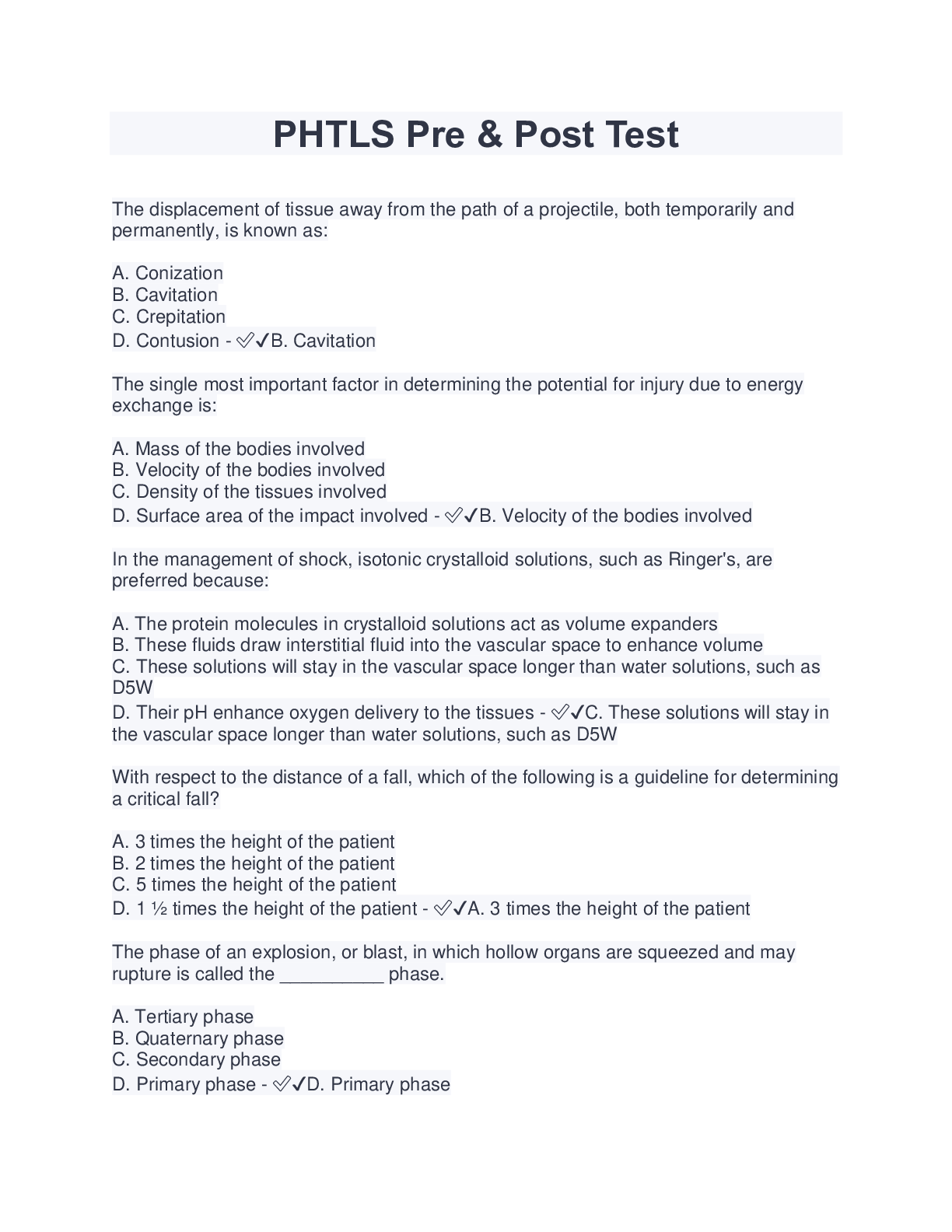
Reviews( 0 )
Recommended For You
Health Care> EXAM > PHTLS Pre & Post Test/75 Questions And Answers/2022 With Complete Solution (Graded A+) (All)
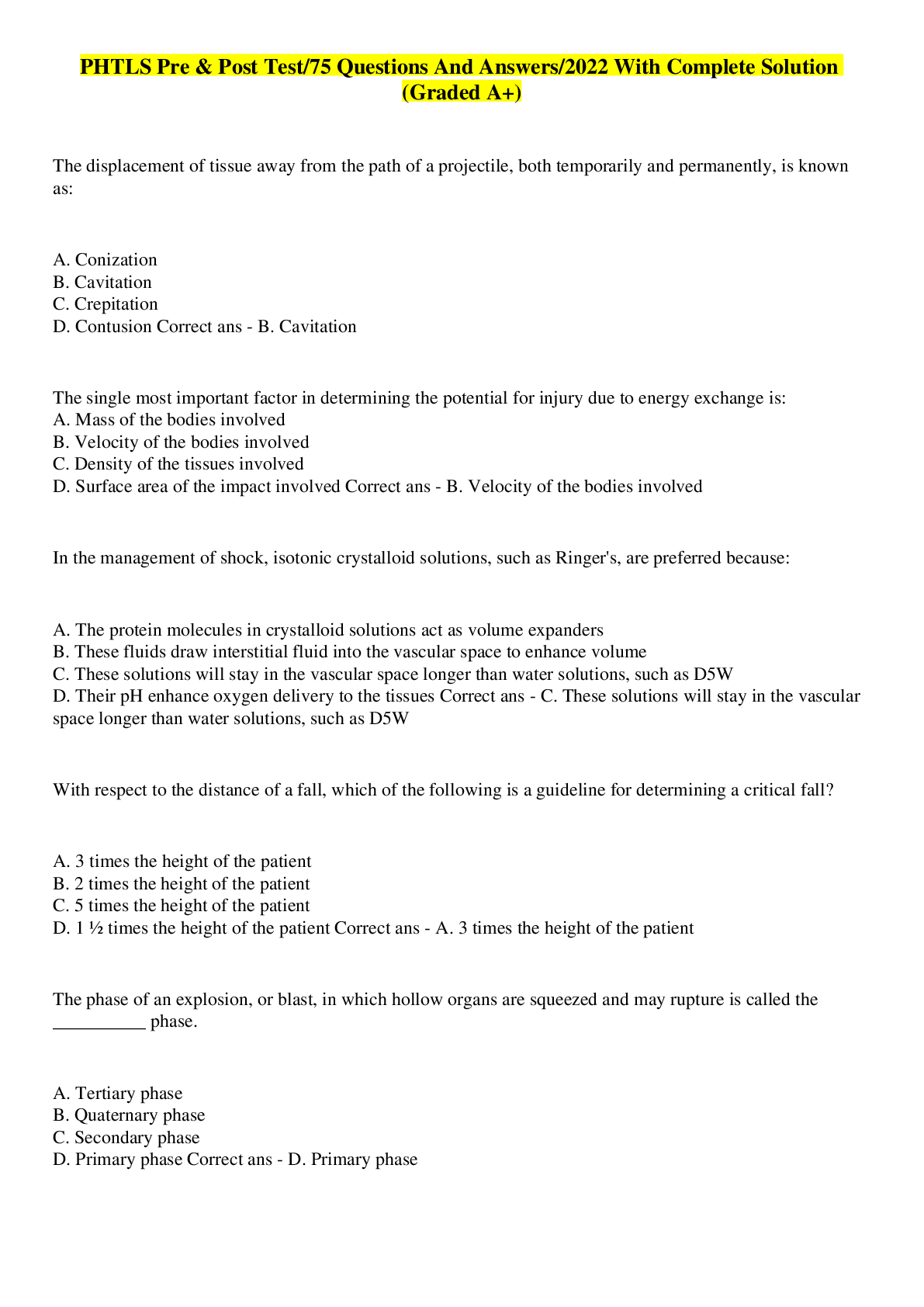
PHTLS Pre & Post Test/75 Questions And Answers/2022 With Complete Solution (Graded A+)
PHTLS Pre & Post Test/75 Questions And Answers/2022 With Complete Solution (Graded A+)
By Filbert , Uploaded: Dec 04, 2022
$9
Health Care> EXAM > LETRS Units 1 - 4 Pre & Post Test Questions and Answers (2022/2023) (Verified Answers) (All)
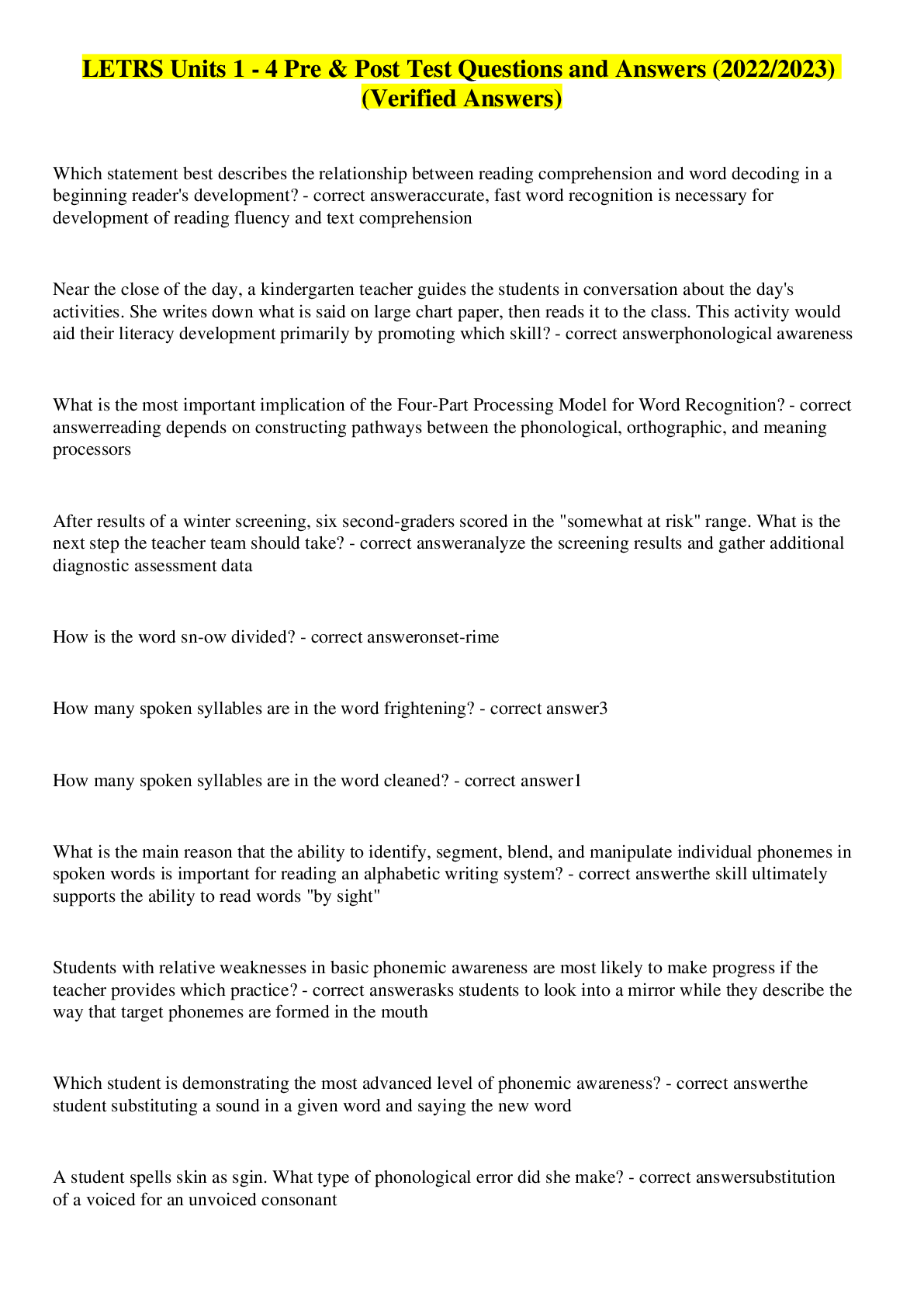
LETRS Units 1 - 4 Pre & Post Test Questions and Answers (2022/2023) (Verified Answers)
LETRS Units 1 - 4 Pre & Post Test Questions and Answers (2022/2023) (Verified Answers)
By Filbert , Uploaded: Dec 07, 2022
$8
English> EXAM > LETRS Units 5 - 8 Pre & Post Test | with 100% Correct Answers (All)
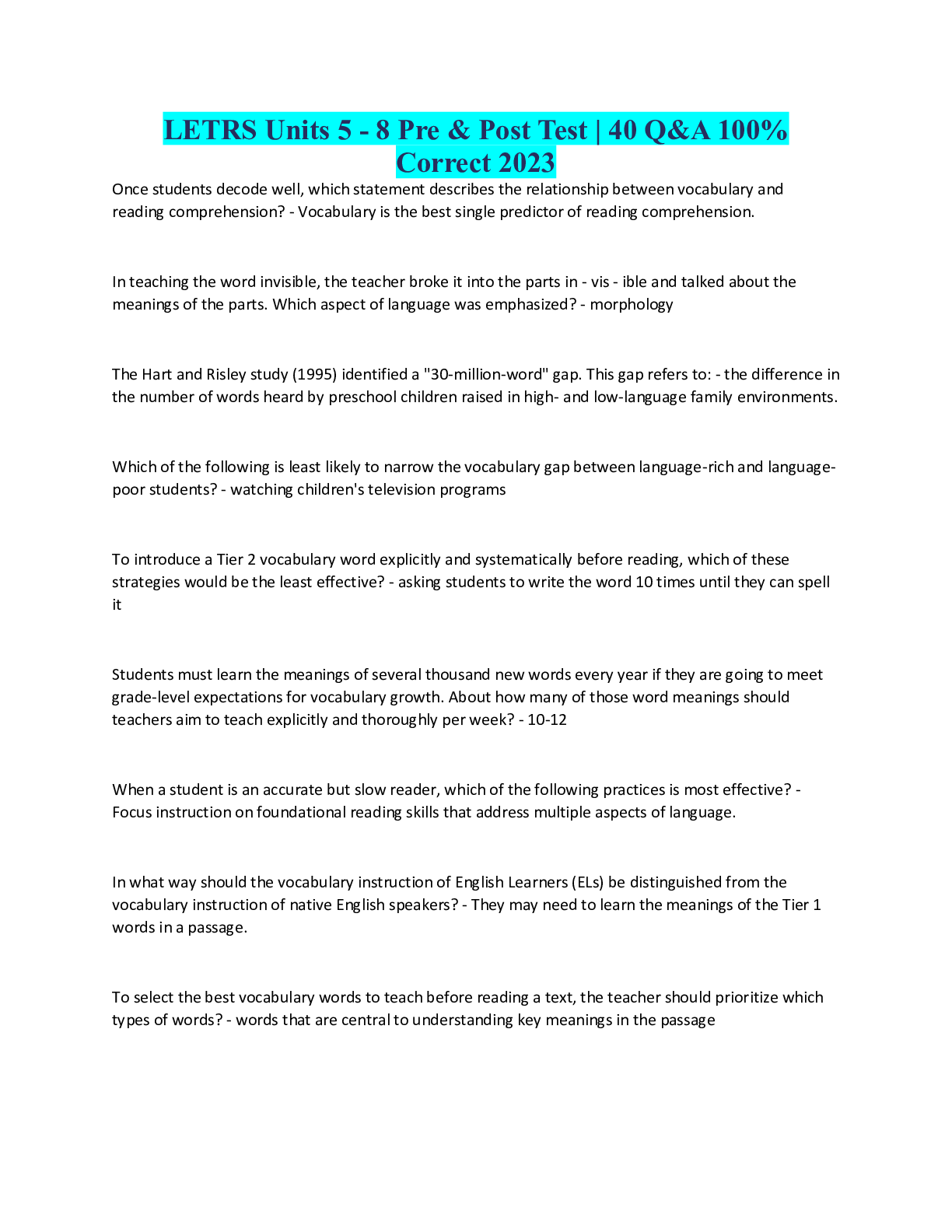
LETRS Units 5 - 8 Pre & Post Test | with 100% Correct Answers
Once students decode well, which statement describes the relationship between vocabulary and reading comprehension? - ✔✔Vocabulary is the best single predictor of reading comprehension. In teaching...
By Tessa , Uploaded: Aug 08, 2022
$5
SCIENCE 101> EXAM > PHTLS Pre & Post Test Questions & Answers_ All correct!!! ( 100%) (All)
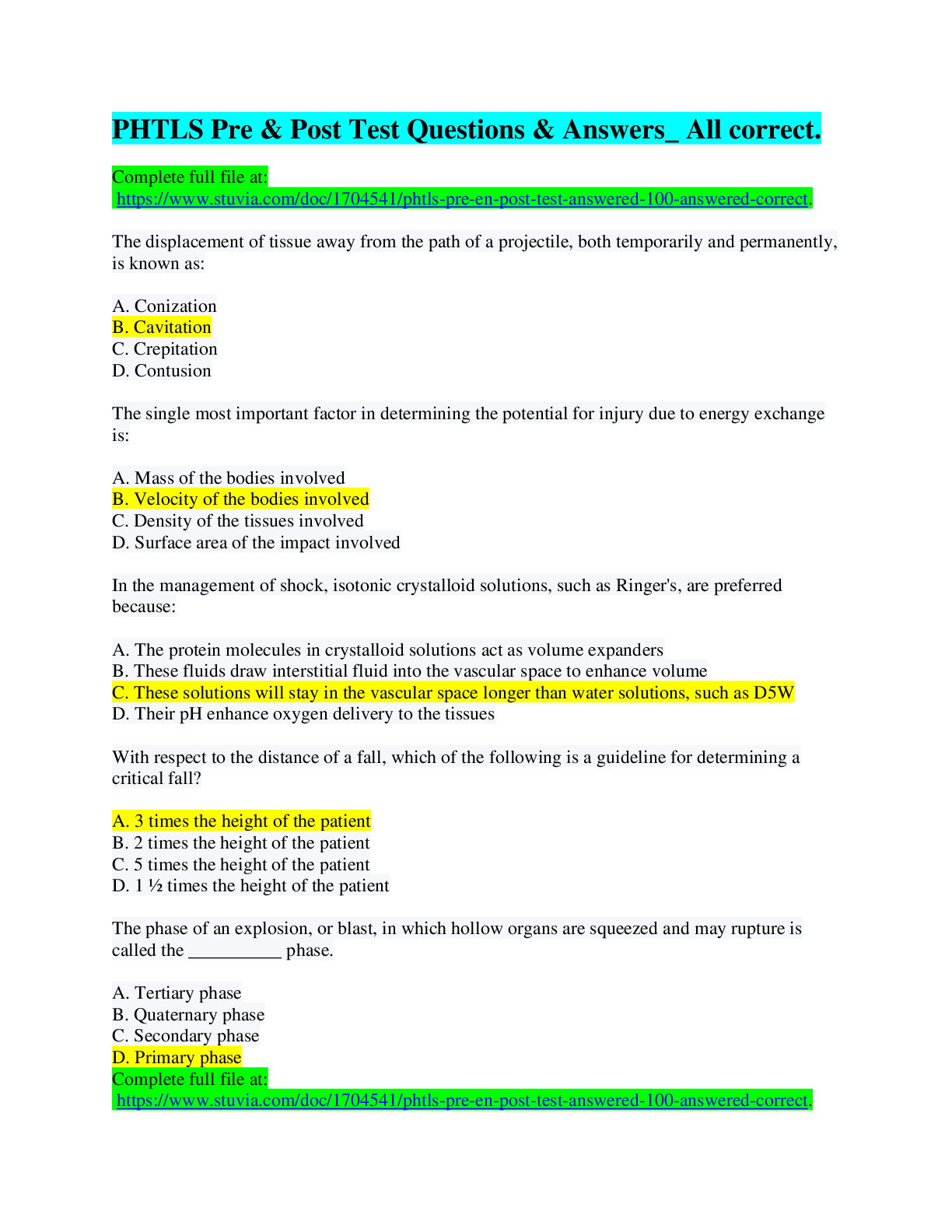
PHTLS Pre & Post Test Questions & Answers_ All correct!!! ( 100%)
PHTLS Pre & Post Test Questions & Answers_ All correct. Complete full file at: https://www.stuvia.com/doc/1704541/phtls-pre-en-post-test-answered-100-answered-correct. The displacement of tissue aw...
By Victor , Uploaded: Jun 03, 2022
$15.5
*NURSING> EXAM > PHTLS Pre & Post Test, Q&A, Answered (All)
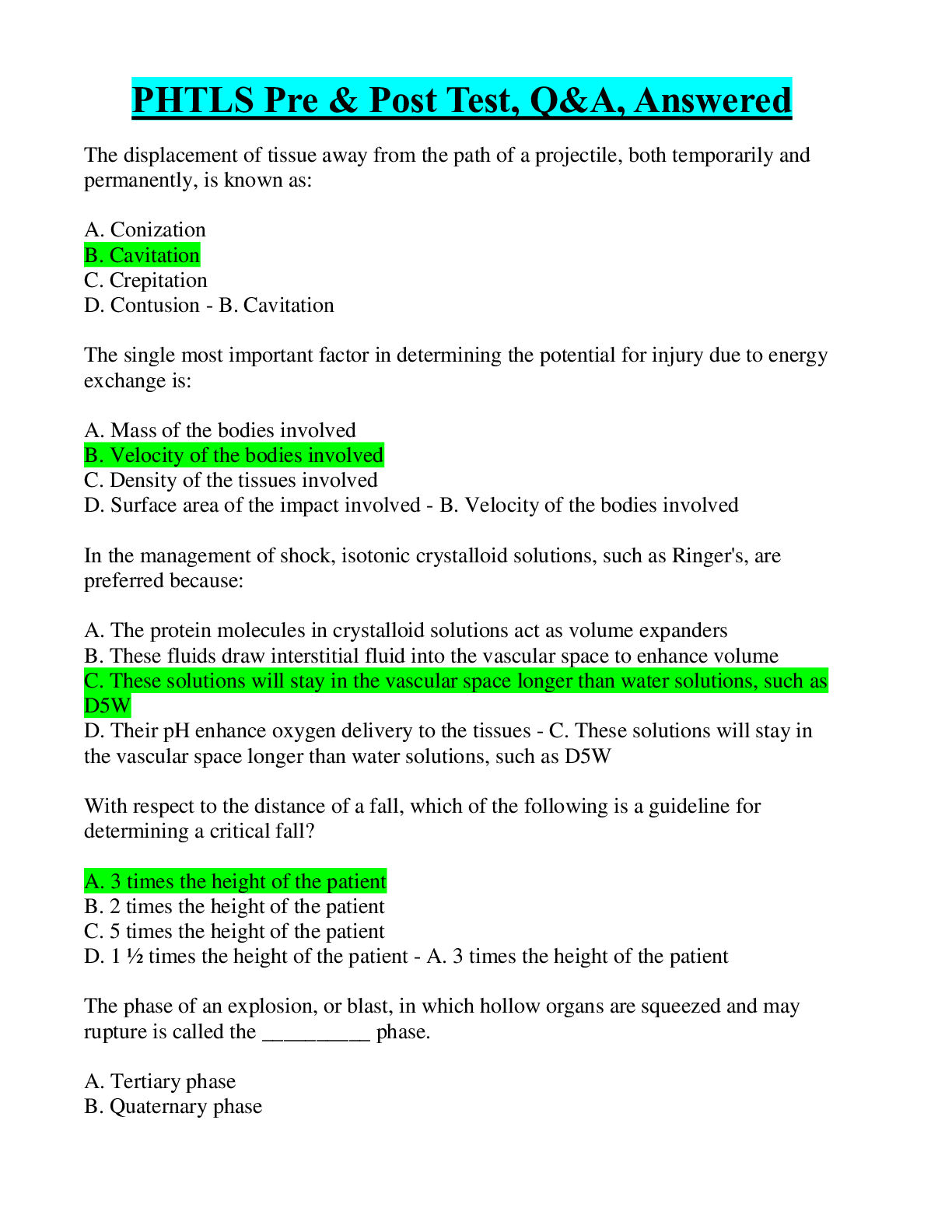
PHTLS Pre & Post Test, Q&A, Answered
PHTLS Pre & Post Test, Q&A, Answered-The displacement of tissue away from the path of a projectile, both temporarily and permanently, is known as: A. Conization B. Cavitation C. Crepitation...
By PROF , Uploaded: Apr 28, 2022
$13.5
Health Care> EXAM > PHTLS Pre & Post Test 2023 With Complete Solution (All)
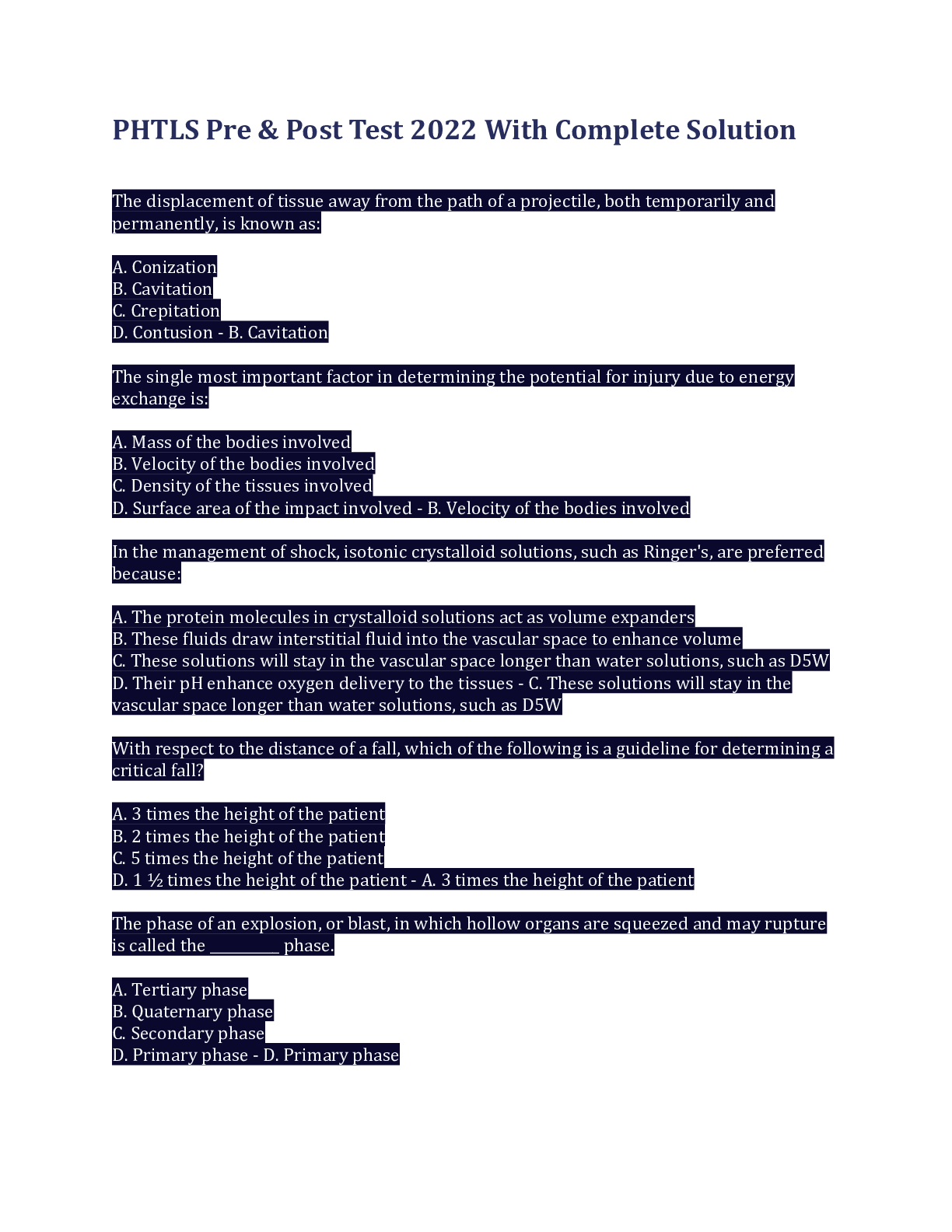
PHTLS Pre & Post Test 2023 With Complete Solution
PHTLS Pre & Post Test 2023 With Complete Solution
By Academic mines , Uploaded: Jan 28, 2023
$11
Education> EXAM > TEST BANK FOR ALL SETS OF LETRS UNIT 1 8 WITH COMPLETE SESSIONS IN ALL UNITS ASSESSMENTS , PRE & POST TEST , MODULES COMPLETE SOLUTIONS 100% |VERIFIED (All)
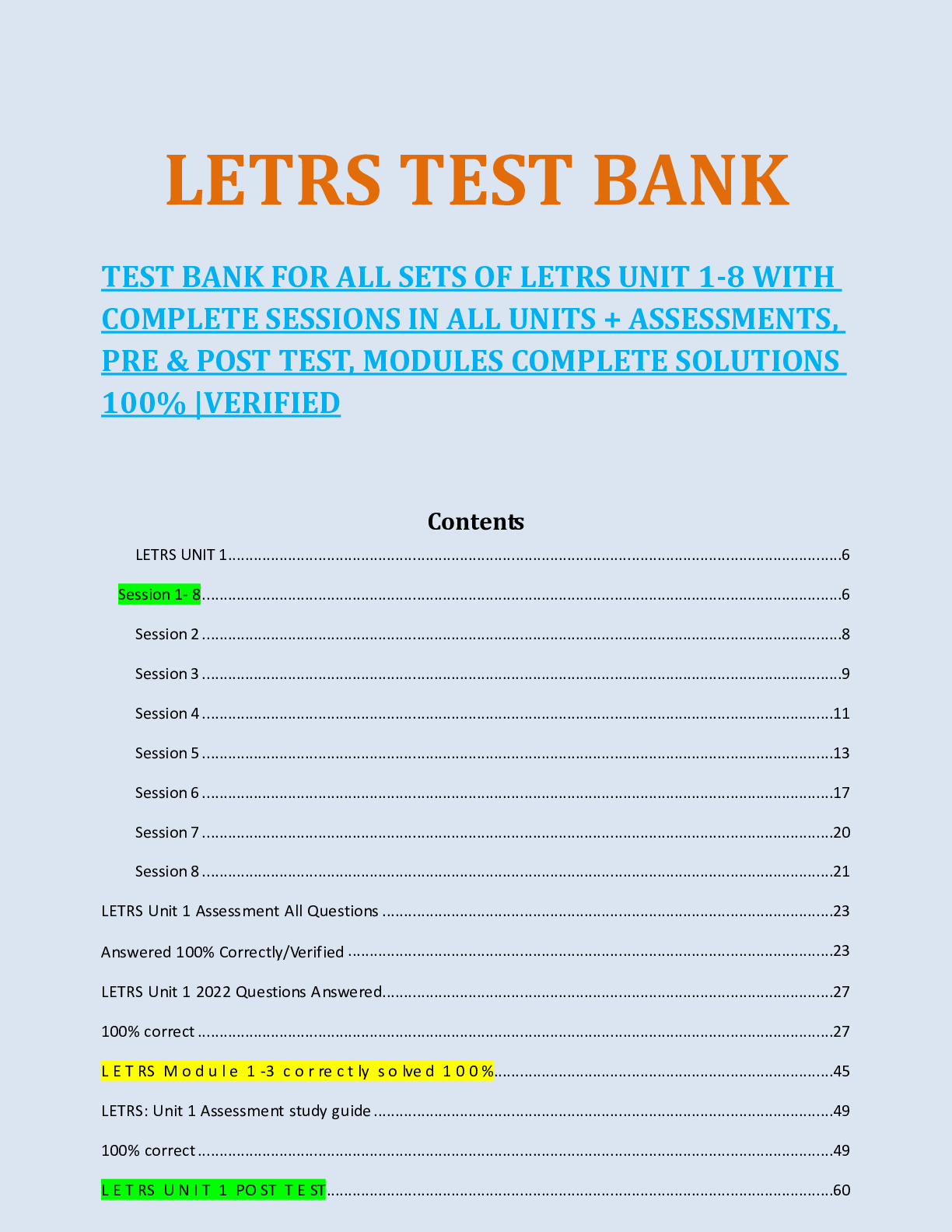
TEST BANK FOR ALL SETS OF LETRS UNIT 1 8 WITH COMPLETE SESSIONS IN ALL UNITS ASSESSMENTS , PRE & POST TEST , MODULES COMPLETE SOLUTIONS 100% |VERIFIED
LETRS TEST BANK TEST BANK FOR ALL SETS OF LETRS UNIT 1 8 WITH COMPLETE SESSIONS IN ALL UNITS ASSESSMENTS , PRE & POST TEST , MODULES COMPLETE SOLUTIONS 100% |VERIFIED Contents LETRS UNIT 1........
By SteadfastExams , Uploaded: Mar 22, 2023
$16
Health Care> EXAM > LETRS Units 5 - 8 Pre & Post Test: Questions & Answers: Updated A+ Solution (All)

LETRS Units 5 - 8 Pre & Post Test: Questions & Answers: Updated A+ Solution
Once students decode well, which statement describes the relationship between vocabulary and reading comprehension? (Ans- Vocabulary is the best single predictor of reading comprehension. In teac...
By Joy100 , Uploaded: Nov 27, 2022
$7
Military Studies> EXAM > SEJPME Mod 5 pre & post test American Military University JKO SEJPME | with 100% Correct Answers (All)
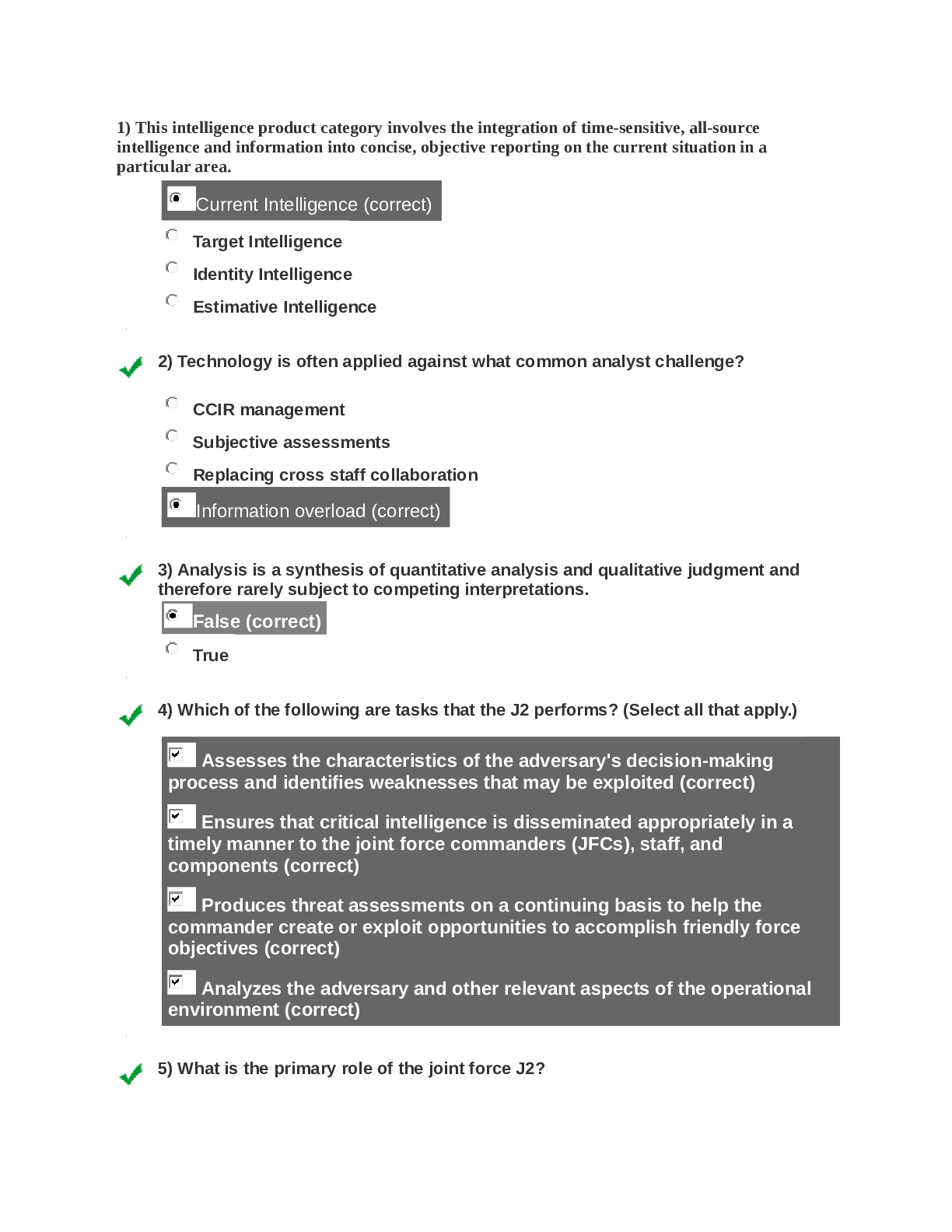
SEJPME Mod 5 pre & post test American Military University JKO SEJPME | with 100% Correct Answers
1) This intelligence product category involves the integration of time-sensitive, all-source intelligence and information into concise, objective reporting on the current situation in a particular a...
By Wanjiku , Uploaded: Oct 12, 2022
$10
*NURSING> EXAM > TEST BANK FOR ALL SETS OF LETRS UNIT 1-8 WITH COMPLETE SESSIONS IN ALL UNITS + ASSESSMENTS, PRE & POST TEST, MODULES COMPLETE SOLUTIONS 100% |VERIFIED (All)
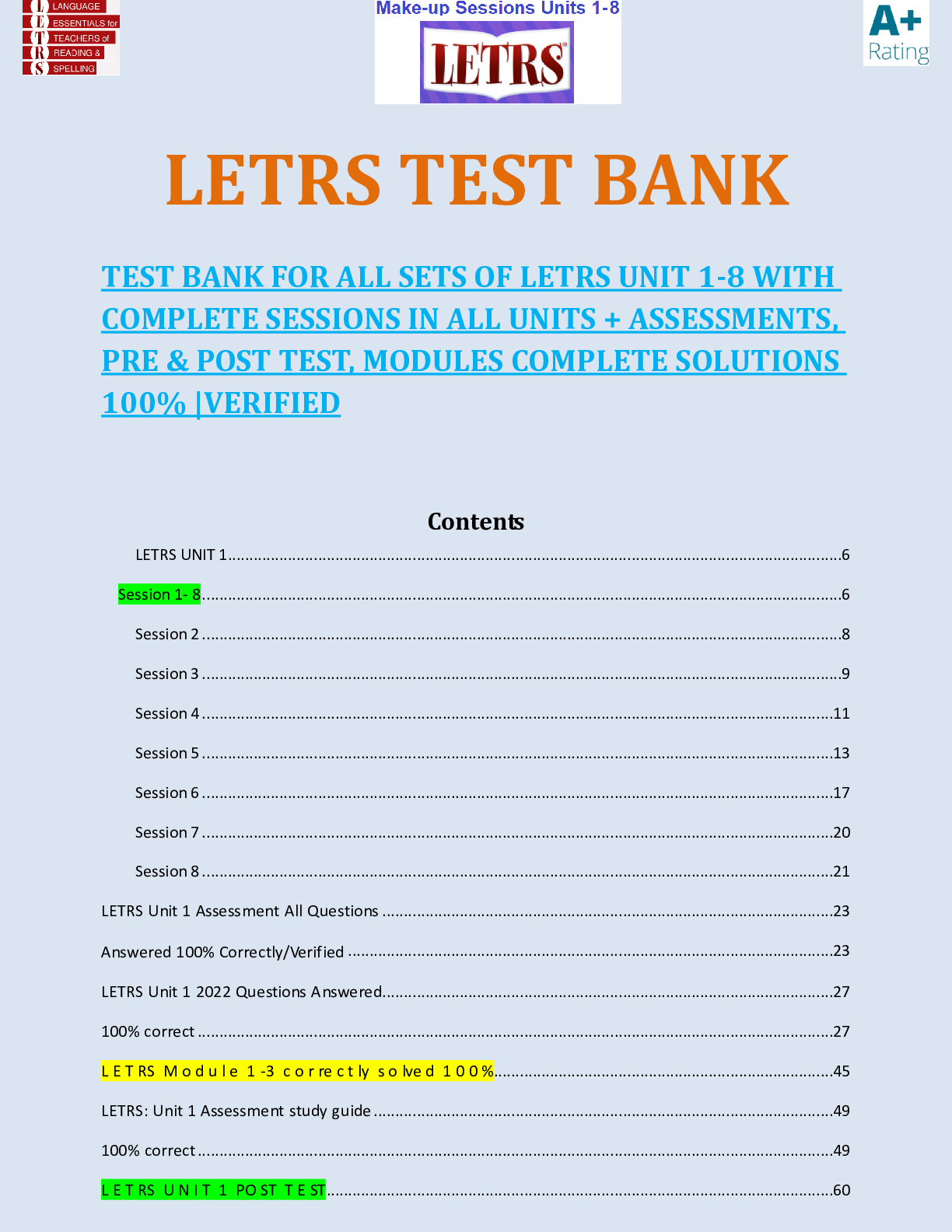
TEST BANK FOR ALL SETS OF LETRS UNIT 1-8 WITH COMPLETE SESSIONS IN ALL UNITS + ASSESSMENTS, PRE & POST TEST, MODULES COMPLETE SOLUTIONS 100% |VERIFIED
TEST BANK FOR ALL SETS OF LETRS UNIT 1-8 WITH COMPLETE SESSIONS IN ALL UNITS + ASSESSMENTS, PRE & POST TEST, MODULES COMPLETE SOLUTIONS 100% |VERIFIED
By Margaret020 , Uploaded: Sep 11, 2023
$19.5
Document information
Connected school, study & course
About the document
Uploaded On
Apr 28, 2022
Number of pages
14
Written in
Additional information
This document has been written for:
Uploaded
Apr 28, 2022
Downloads
0
Views
136






